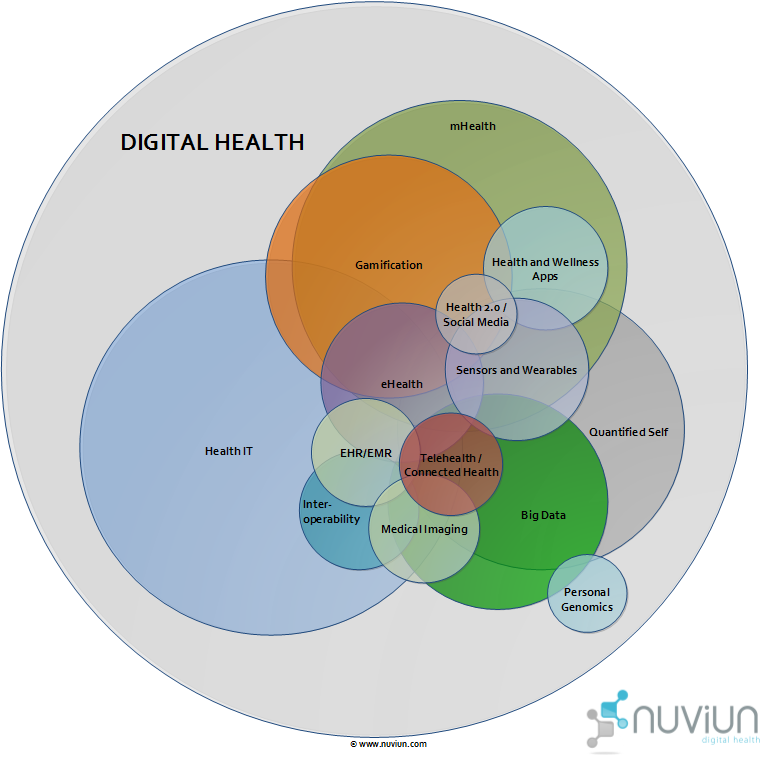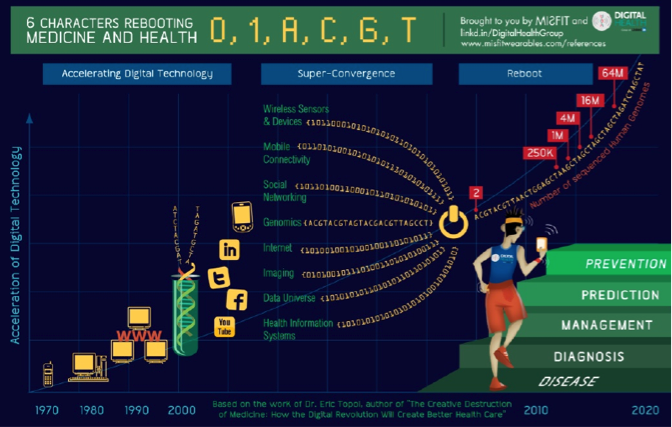Digital health pioneer Paul Sonnier says now that digital health has inundated healthcare like a tsunami, we need to take the next step forward and see how its adoption benefits our health and our options.
Digital health is taking the world by storm, and our health plus the delivery of health care will never be the same. The profound impact and limitless potential in this field is what drives my mission to catalyze innovation, adoption, and the health benefits that can be derived from everything digital health has to offer.
It’s an enormous and diverse industry, and nomenclature has been something many have struggled with—which is why I’ve invested effort in creating and curating resources that seek to inform, clarify and connect those who want to jump into the fray.
From the Beginning
Let’s open this story at the beginning: what is digital health? While the term has been around for many years, it lacked a fundamental new aspect: genetics and genomics. DNA is, in fact, a digital molecule, comprised of a code that’s made up of four base pairs — A, T, C, and G nucleobases — vs. a computer processor’s instructions using a binary number system of digits, 0 and 1.
This simple, yet major digital addition inspired me to author the first definition of “digital health” on Wikipedia in early 2013:
“Digital health is the convergence of the digital and genetics revolutions with health and healthcare with the goal of reducing inefficiencies in healthcare delivery, improving access, reducing costs, increasing quality, and making medicine more personalized and precise.”
It’s a mouthful, but it’s making life better for millions of people across the globe each and every day.
In the evolution of digital health, two leading luminaries have inspired me: Dr. Eric Topol, author of The Creative Destruction of Medicine: How the Digital Revolution Will Create Better Health Care; and J. Craig Venter, author of Life at the Speed of Light: From the Double Helix to the Dawn of Digital Life.
In following the work of both, I saw a concise description of the digital innovations I’d been witnessing as they converged with health and healthcare: wireless devices and networks, microprocessors, information technology, social networking, the Internet, and biometric sensors; plus genetics and genomics. This synthesis of enabling digital technologies is presented in a beautiful graphical format by nuviun, in the Venn diagram they created to describe the digital health landscape.

Digital health is already here and in widespread use. But, stealing a famous line from novelist William Gibson, “The future is already here — it’s just not very evenly distributed.” The same holds true for digital health. It’s already empowering us in a multitude of ways to manage and optimize our own health, and it’s transforming and disrupting our healthcare systems and the manner in which we receive health care. Let’s take a look at how some of this is happening.
The Consumerization of Health
The digital revolution has enabled a consumerization of health. It may sound lofty, but it’s exactly what needed to happen, since the outcome is consumer empowerment, and fulfilling consumer needs is a driving factor behind any innovative process.
Here we have consumers armed with smartphones, apps, and the Internet to better manage their own health and that of their families. This facet of digital health is not bogged down by monolithic influences, but fuelled by the abundance of innovators who connect directly with consumers, delivering their goods and services to eagerly awaiting mobile and other connected devices.
With such readily available technology, these informed and empowered consumers are going to increasingly want more, which has created a disruptive force in terms of consumer demands on healthcare systems. They are requiring providers to leverage the latest in digital health technologies to deliver more responsive and engaged care that is of higher quality and provides improved access.
A great example of this can be seen in the rapid growth of retail clinics, as can be found in CVS and Walgreens. These have been created in part to meet the demands of consumers for increased access and convenience, and digital health tools are being used within their in-store health service centers to optimize care and meet consumer needs.
The Digitization of Healthcare
In addition, this revolution — coupled with government incentives in the US — has resulted in an accelerating digitization of healthcare systems and records. With the federal Electronic Health Records (EHR) Incentive Program that began in 2011, healthcare providers have increasingly jumped on board to both fulfil requirements, and to optimize care through the efficiencies and cost reductions that digital health offers.
This is mostly occurring in Health IT, which unfortunately is still comprised of many siloed systems that lack the effective interoperability that would optimize digital health’s potential. Issues of proprietary processes and stagnant environments are often the culprits here, but there are a number of new initiatives underway that show great promise to advance progress on this front.
There is much overlap in digital health, and if the interoperability challenges of Health IT can be solved, it will be enormously valuable to create and grow effective interfacing with the multitude of consumer health products and services available on the market. There are hundreds, if not thousands, of startups entering and further fuelling this vortex to deliver new solutions. Among them:
- ZocDoc — online scheduling to optimize efficient use of physician appointments / time;
- Proteus Digital Health — monitoring and management of medications, creating ‘smart’ pills;
- HealthTap — online doctor consultations;
- WellDoc — diabetes management app with support that is FDA cleared;
- Dexcom — continuous glucose monitoring;
- Apple — newly launched digital health tracking app that integrates with wearables and cloud data;
- Apple/Epic EMR partnership — brand new effort that should provide amazing outcomes;
- Samsung— new efforts for consumer health, B2B sensor platform initiatives and potential partnerships with Epic and healthcare organizations.
A New Digital Health Paradigm
To varying degrees, all of this is moving us toward a new digital health paradigm, especially with anticipated new innovations coming down the pike in terms of non-invasive biometric sensors, diagnostics, and genetics. We’re more informed about our health, can proactively avoid disease, improve our current health and better manage health conditions, avoid hospitalizations, and prevent or minimize hospital readmissions.
In other words, digital health can help us optimize our health and the delivery of healthcare itself.
This is happening, sometimes slowly and sometimes at great speed, as we are aided in a holistic fashion to avoid and better manage chronic disease, experience improved access to care through models such as retail clinics and telehealth services, and enhance continuity of care by giving our doctors the essential information they need to provide us with informed and coordinated care.
Here’s a simple illustration of where all of this takes us:

Digital health presents a fairly similar opportunity to the organic foods movement, where consumers and industry (agriculture/food producers and grocery retailers) worked together to accelerate change. The tools are mostly already here, just not evenly distributed or optimized.
It’s up to us, and our desire for change, better solutions, and more efficient higher quality healthcare, to drive the revolution forward. Sometimes, we’ll have plodding progress. At other times, we’ll experience radical industry disruptions being wrought by digital companies in other sectors like Uber, Airbnd, and Tesla Motors. Consumers can speak with their pocket books to bring the future to bear a lot sooner than some might say is possible.
I’m excited about this change, which while never easy, ultimately benefits us and our families.
This article first appeared in Innovation & Tech Today. Reprinted with permission.

